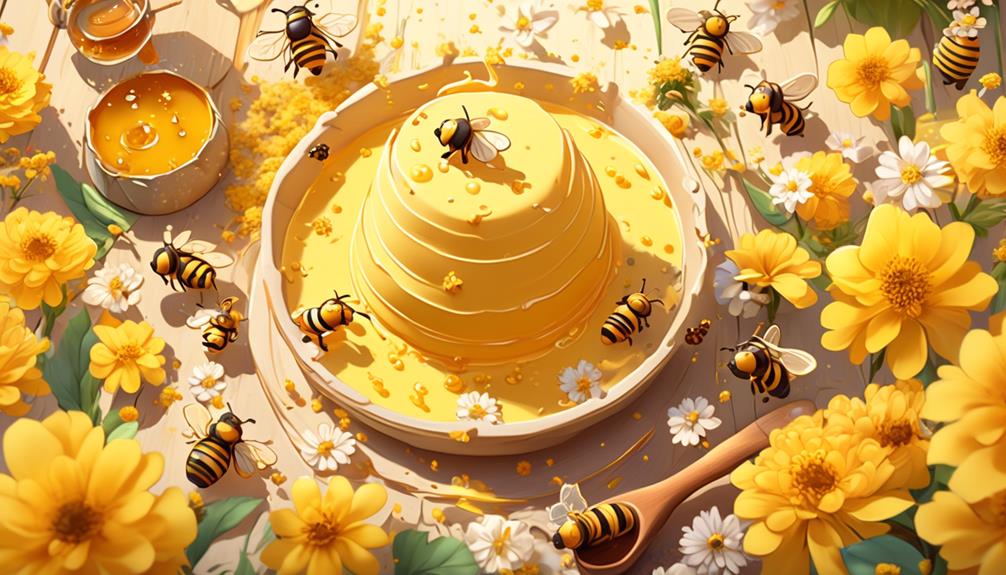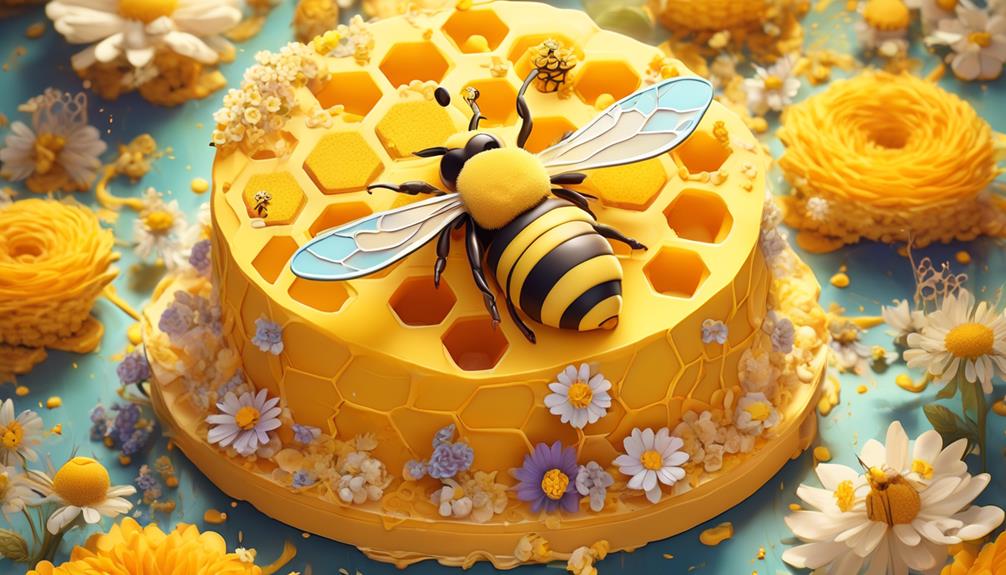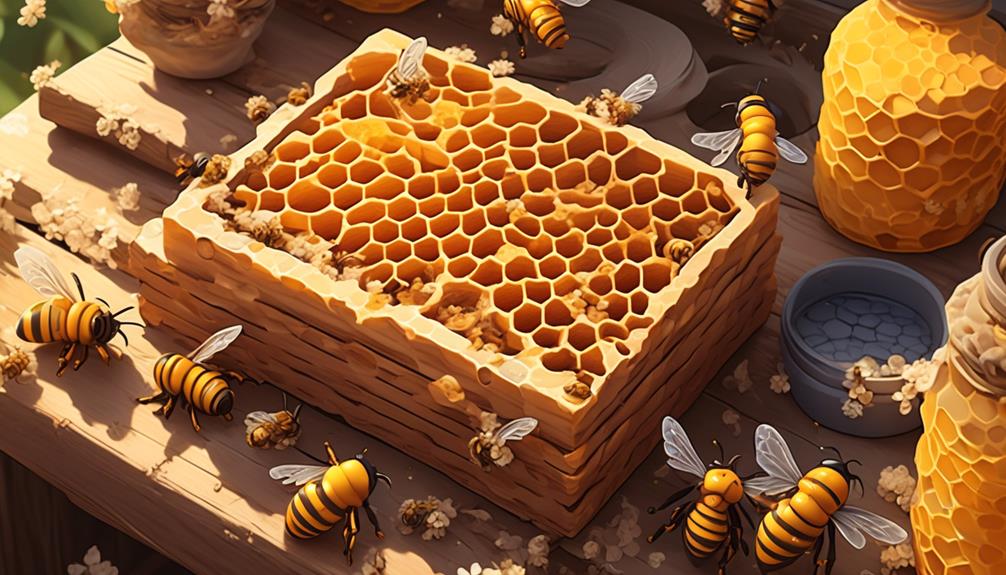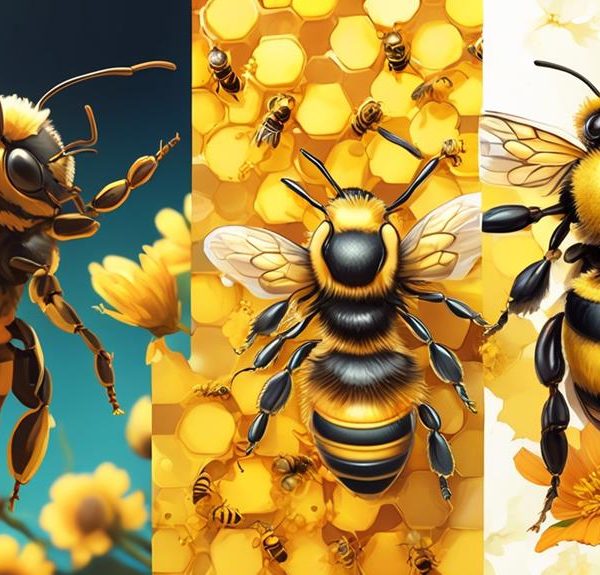Journey into the world of beekeeping and discover how to make fondant to keep your bees buzzing through the winter months.

How to Make Fondant for Bees?
When the cold season comes knocking, bees aren't just kicking back and sipping honey in their cozy hives. You, as a beekeeper, know they're actually facing an uphill battle to maintain their food supplies. It's your job to ensure these industrious little workers are well-fed and ready to bounce back when spring arrives.
But what's the best way to give your buzzing friends the sustenance they need during these lean months? One word: fondant. And, no, we're not talking about the kind you find on fancy cakes.
Intrigued? Let's pull back the curtain and explore this vital aspect of beekeeping.
Key Takeaways
- Bees require both sugars and pollen for their nutrition needs.
- Proper feeding and care are essential for the health and productivity of bees.
- Fondant provides necessary energy reserves for bees during winter when natural food sources become scarce.
- Well-fed bees in winter are healthier and more productive in spring, leading to a plentiful honey harvest.
Understanding Bee Nutrition Needs

To keep your bees healthy and productive, it's crucial to understand their nutritional needs, which primarily consist of sugars for energy, and pollen for protein. You've got to remember, bees aren't just honey producers; they're also hardworking pollinators that require proper feeding and care.
Now, let's talk about sugar. Bees need carbohydrates to fuel their flight muscles and keep the hive warm during winter. Nectar from plants is their natural source, but when flowers are scarce, you can supplement with sugar syrup or fondant. Be cautious, though. Don't use artificial sweeteners. They can't digest them and it could harm your little buzzing friends.
On the other hand, pollen is their protein source. It's necessary for bee growth and development. It's also essential for the queen bee to lay eggs. In spring, when there are plenty of flowers, bees collect enough pollen. But in times of dearth, you might need to provide a pollen substitute.
Lastly, bees need water for hydration and hive cooling. Ensure there's a clean water source available nearby.
Understanding and meeting your bees' nutritional needs isn't just a part of responsible beekeeping, it's ensuring their survival and productivity.
Importance of Winter Feeding

As winter rolls in, it's vital you understand the importance of feeding your bees, particularly since natural food sources become scarce during these cold months. Bees, like other insects, rely on natural nectar and pollen for sustenance. But when flowers aren't in bloom, what can they consume? This is where your role as a beekeeper becomes crucial.
Winter feeding is more than just charity; it's a lifeline for your hive. Bees need energy to keep their colony warm, and without enough food, they can't generate this heat. The hive's survival hangs in the balance. By providing fondant, a type of sugar candy, you're effectively ensuring your bees have the energy reserves they need to make it through the winter.
Moreover, feeding bees in winter helps them get a head start on spring. Bees that are well-fed during the cold months will be healthier and more productive when spring arrives. They'll be able to start foraging and reproducing earlier, which could lead to a more plentiful harvest of honey come summer.
The Basics of Bee Fondant

Understanding the essentials of bee fondant can make all the difference in your winter feeding routine, ensuring your hive not only survives the cold months but also thrives come spring. Bee fondant is a type of sugar candy that's easy to make and ideal for feeding bees when flowers aren't available. It's soft, pliable, and easily digestible for your bees.
Bee fondant requires two essential ingredients: water and sugar. You'll need to heat the sugar with a small amount of water until it reaches a specific temperature. This process, known as inversion, breaks down the sugar into simpler compounds that are easier for bees to digest.
Here's a simple breakdown of the main components:
Ingredient | Purpose |
|---|---|
Sugar | Main food source for bees |
Water | Used to dissolve and heat the sugar |
Step-by-Step Fondant Recipe

If you're ready to create your own bee fondant, let's dive into a step-by-step recipe that will make the process straightforward and simple.
First, gather your ingredients. You'll need 5 cups of white granulated sugar, 2 cups of water, and a pinch of salt. Also, prepare your tools: a large pot, a candy thermometer, and a mold or a flat surface covered with wax paper.
Begin by pouring the sugar and the pinch of salt into your pot. Add the water gradually, stirring until the sugar completely dissolves. Bring the mixture to a boil over medium heat, then reduce the heat to a simmer. It's crucial to monitor the temperature closely using your candy thermometer. You're aiming for a temperature of 238°F (114°C), also known as the 'soft ball' stage in candy making.
Once you've reached that temperature, remove the pot from the heat. Allow the mixture to cool without stirring until it's lukewarm. Then, beat it vigorously until it becomes a thick, white paste.
Pour the fondant onto your mold or wax paper, let it harden, and voila! You've made bee fondant. Remember, always cool before giving it to your bees.
Storing and Using Bee Fondant

Once you've made your bee fondant, it's crucial to store it correctly for long-term use and to ensure it remains in optimal condition for your bees. The best way to store fondant is in an airtight container at room temperature. Avoid exposing it to extreme heat or cold, as this can cause it to dry out or become too hard.
When it's time to use the fondant, simply remove it from the storage container and break it into pieces. You can place these pieces directly onto the top bars of your bee frames. The bees will consume the fondant as a supplementary food source, particularly in the colder months when natural food sources are scarce.
Here's a handy table to summarize:
Storage Condition | Effect on Fondant |
|---|---|
Room Temperature | Optimal |
Extreme Heat | Too Hard |
Extreme Cold | Dries Out |
Direct Sunlight | Can Melt |
Damp Conditions | Can Dissolve |
Frequently Asked Questions
Can Bees Develop a Preference for Certain Types of Fondant?
Yes, bees can develop a preference for certain types of fondant. It's not uncommon for beekeepers to notice that their bees favor one type of fondant over another.
This preference can be influenced by factors like the sugar content, texture, and even the color of the fondant. You'll need to experiment with different types to see what your bees like best.
How Does the Climate or Weather Affect the Process of Making Bee Fondant?
Weather can indeed influence your fondant-making process. If it's too humid, your fondant mightn't set properly, becoming too sticky. In colder temperatures, you'll notice it hardens quicker. Ideally, you'd make it in a cool, dry environment.
You'll need to adjust your recipe and process depending on the climate. So, keep an eye on the weather and don't be afraid to experiment a bit to get the consistency just right.
Is There Any Risk of Bees Becoming Reliant on Fondant and Losing Their Natural Foraging Instincts?
There's no need to worry about bees losing their foraging instincts by relying on fondant. Bees are instinctively foragers and will always prefer natural sources. Fondant is just a supplement, particularly useful during winter when food sources are scarce.
However, it's important not to overfeed them with fondant, so they don't become lazy. Always monitor their consumption and adjust accordingly.
Can Homemade Fondant Be Harmful to Bees if Not Made Correctly?
Yes, if you don't make homemade fondant correctly, it can be harmful to bees. The sugar to water ratio is crucial for their digestion. If it's off, the bees can't process the fondant properly and may become dehydrated.
Also, never add artificial coloring or flavors, as these can be toxic to bees. Always use pure, white sugar and clean water to ensure the fondant is safe for them.
Are There Any Alternatives to Fondant for Feeding Bees During Winter?
Yes, there are alternatives to fondant for feeding bees during winter.
You can consider sugar syrup or dry sugar, but remember, they're not as efficient as fondant.
Sugar syrup can freeze in colder climates and dry sugar isn't as easy for bees to consume.
It's also crucial to ensure your bees have plenty of honey stored, as it's their natural food source and the best option for winter survival.
Conclusion
You've now grasped the importance of winter feeding and bee nutrition. With this simple fondant recipe, you're ready to support your buzzing friends during those cold months.
Remember, storing the fondant properly ensures its longevity. Use it wisely, it's more than just food, it's a lifeline for your bees.
Keep learning, keep feeding, and continue to contribute to the health and longevity of your hardworking bees. Your efforts will surely pay off with a thriving hive.


